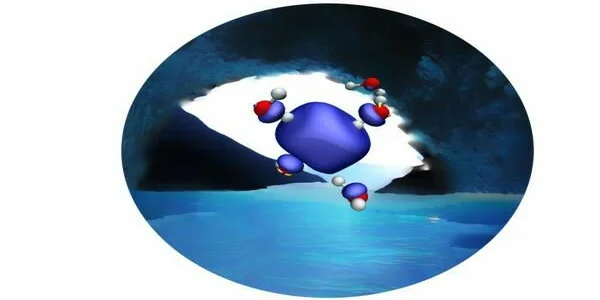4:30 PM Novel MD simulation sheds lightweight on mystery of hydrous electron's structure | |
Extra electrons solvated in liquid water, referred to as hydrous electrons, were initial according fifty years agone. However, their structure continues to be not well understood. MARVEL researchers at the University of Zurich, ETH and also the Swiss National Supercomputing Center CSCS have currently taken a step toward resolution the mystery. Their paper, "Dynamics of the majority hydrous negatron from several Body Wave operate Theory," has been printed in Angewandte Chemie. The e-aq species is tough to watch directly as a result of it's transitory and can't be separated or focused. This rules out victimization direct structural approaches, optical phenomenon or nuclear magnetic resonance spectroscopic analysis to explore its structure. tho' some properties as well as spectra in ultraviolet illumination and IR-regions and also the energy are directly ascertained, the final lack of direct experimental measurements of the structure of the hydrous negatron demand theory. Reliable modeling of the hydrous negatron is a minimum of as difficult because the experimental approach, and also the limitations of process approaches applied thus far have light-emitting diode to considerable theoretical uncertainty. Researchers haven't, as an example, been able to agree on whether or not or not the hydrous negatron occupies a cavity. tho' most theoretical studies counsel that it will, non-cavity models have conjointly tested correct. Another purpose of dialogue is joined to the distinguishable surface and bulk structures of the hydrous negatron. In the paper, researchers Vladimir Rybkin and Jan Wilhelm at the University of Zurich and Joost VadeVondele at ETH Zurich and CSCS used the primary molecular dynamics simulation of the majority hydrous negatron supported related wavefunction theory to supply conclusive proof in favor of a persistent tetrahedral cavity created of four water molecules. They conjointly showed that there are not any stable non-cavity structures within the bulk hydrous negatron. The scientists acquired their model through careful thought of what options the foremost correct approach should have. They wished it to be supported molecular dynamics to capture the formation and dynamic transformations of the cavity. They required a many-body related negatronic structure level to avoid delocalization error and to permit for the correlation effects that are found crucial in predicting the association of the electron accurately while not empirical parameters. They wished the simulation to be performed within the bulk underneath periodic boundary conditions to avoid formation of the surface structure and, finally, the strategy ought to give Associate in Nursing correct description of liquid water. The MD simulation fulfills all of those needs. It represents the primary dynamic simulation of a fancy chemical species within the condensed part at the related wave operate level of theory. This was the primary essential step. The second was really carrying it out. Such calculations are technically not possible till recent advances—including those created within their own groups—have allowed for massively parallel many-body theory calculations in the condensed part on progressive supercomputers like those as CSCS. It yet took them regarding one million node hours on the Piz Daint mainframe computer, Europe's quickest. The model showed that a cavity is created inside 250 femtoseconds when the surplus negatron is supplementary to the unflustered liquid water. Critically, the simulation did not notice any proof of non-cavity structures of the majority hydrous negatron in either stable or constancy states. This provides abundant stronger theoretical proof for the cavity model. | |
|
| |
| Total comments: 0 | |
